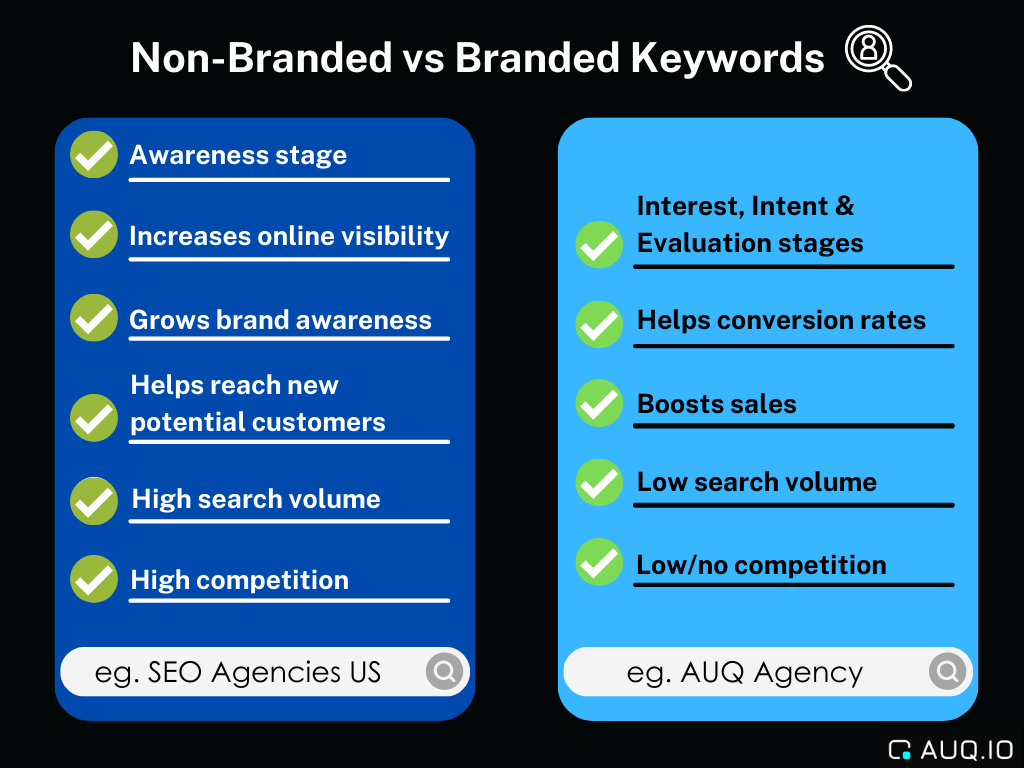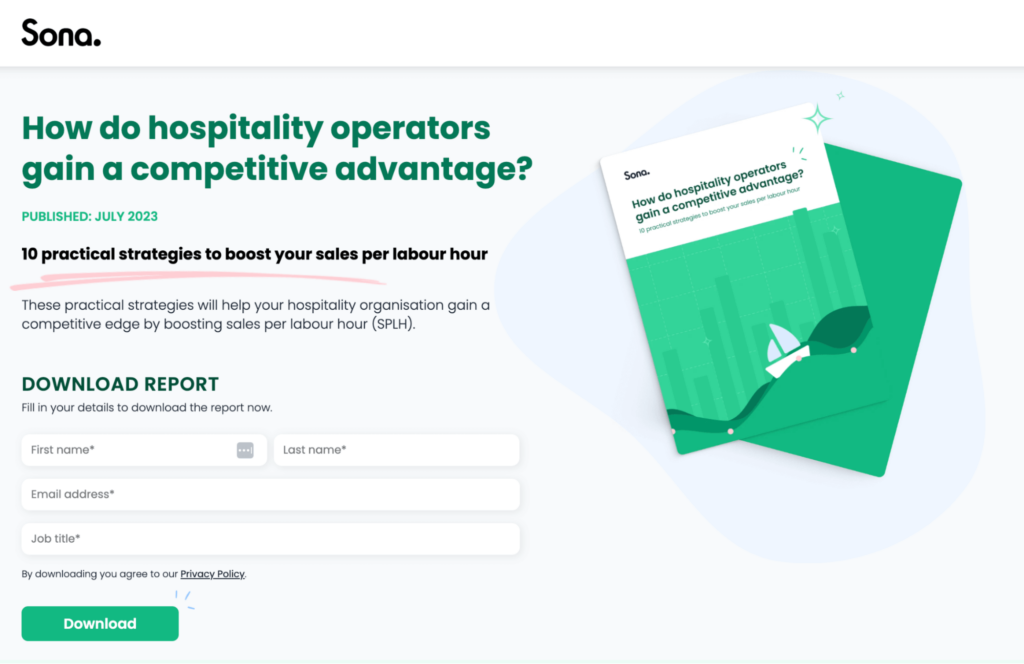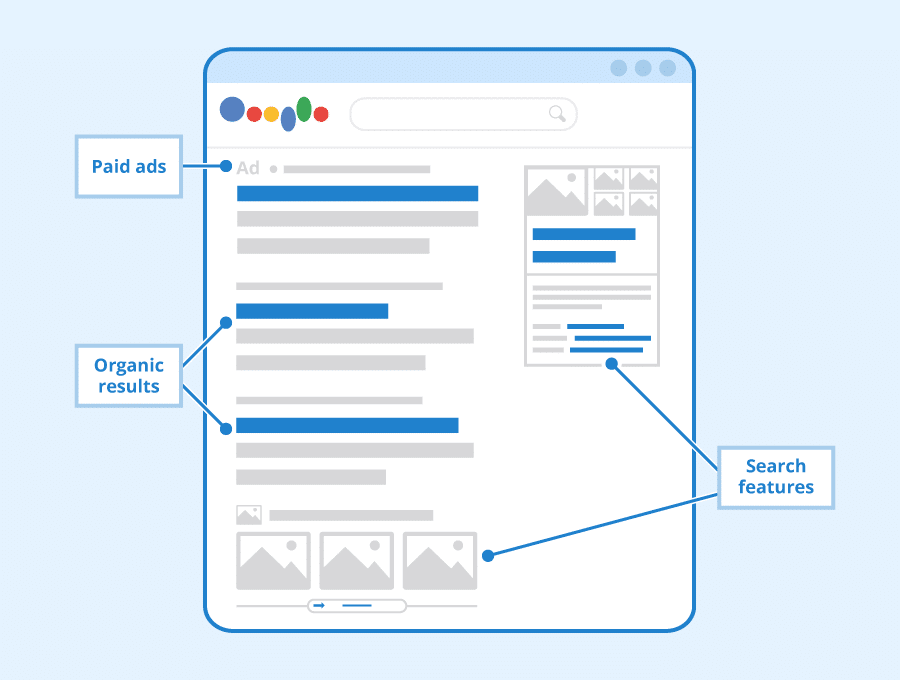In this digital era we’re living in where ‘Google it’ is now a widely used expression, SEO is a crucial aspect for businesses, including B2B companies. To gauge the effectiveness of their SEO strategies, B2B companies need to focus on specific Key Performance Indicators (KPIs) that are tailored to their unique goals. These KPIs provide valuable insights into the performance of SEO efforts and help in optimizing strategies for better online visibility, lead generation, and overall digital marketing success.
These are the 10 most important KPIs B2B companies should be looking out to ensure their SEO strategy is doing what they set out to do:
1. Non-Branded Visibility

Non-branded keywords play a crucial role in reaching untapped customer segments. When people use non-branded keywords to search for products or services related to your business, it indicates that they may not be familiar with your company yet.
Leveraging non-branded SEO keywords not only expands your brand’s online presence but also opens up opportunities to attract new customers and drive sales simultaneously. That’s why one of the essential SEO KPIs for B2B companies is non-branded visibility, which measures the visibility of a website in search results for non-branded or industry-related keywords.
Analyzing which non-branded keywords are bringing in organic traffic can provide valuable insights into audience behavior and keyword targeting–plus, they should be the starting point for your keyword research. Optimizing content for these keywords can help increase organic traffic and attract potential customers searching for industry-related information.
Using Non-Branded Keywords as a KPI:
Non-branded keywords are words or phrases that are not specific to a company’s brand, product, or service. In this case, these could be terms like “commercial kitchen appliances,” “professional food service equipment,” “industrial-grade blenders,” etc. The goal of targeting these keywords is to capture potential customers who are looking for the products or services you offer but may not yet be aware of your brand.
Reporting on Non-Branded Keywords:
KitchenTech would likely want to report on their organic search rankings for these non-branded keywords. This helps them to understand their visibility in the market and their ability to attract new customers who aren’t necessarily searching for their brand name.
Key Metric:
The key metric to track would be the “Organic Search Ranking” for these non-branded keywords. This represents the position that the company’s website appears in the search engine results page (SERP) when these keywords are searched.
Another important metric could be “Organic Search Traffic” – the number of visitors who come to their website through these non-branded search terms. Also, the “Conversion Rate” from these visitors can give an idea about how well these keywords are performing in attracting the right kind of customers.
Tools:
Google Search Console is a free tool that provides insights into a website’s presence in Google’s SERPs. You can use this tool to track the performance of specific keywords, including their click-through rates (CTR), impressions, and position in the SERPs.
Additionally, tools like SEMRush or Ahrefs can provide deeper insights, including keyword difficulty, the potential traffic the keyword can generate, as well as a competitive analysis to understand how competitors are performing on the same keywords.
2. Webinar Conversion Rate
For B2B companies, webinars are a powerful tool for lead generation and building authority in the industry. The Webinar Conversion Rate measures the percentage of webinar attendees who take the desired action, such as filling out a lead form or subscribing to a service. Based on a recent study, the webinar conversion rates in Q4 2022 reached an impressive 56%, meaning that over half of webinar attendees successfully took the action that the business intended (eg. trying a demo, signing up for a newsletter, subscribing to their services, etc).
Tracking this KPI helps identify the effectiveness of webinar topics, content, and presentation, allowing companies to refine their webinar strategies for better lead conversion and engagement.
Using Webinar Conversion Rate as a KPI:
Let’s consider a hypothetical B2B Software as a Service (SaaS) company “CloudManager” that offers cloud management solutions to other businesses. They often run webinars to educate potential customers about the challenges of cloud management and how their solution can help.
CloudManager uses webinars to attract, engage, and convert prospective clients. The “webinar conversion rate” KPI would then be the percentage of webinar attendees who take a desired action after the webinar – for instance, signing up for a free trial of their cloud management software, or requesting a demo.
Reporting on Webinar Conversion Rates:
CloudManager would need to report on the performance of their webinars, specifically focusing on how well they’re converting attendees into leads or customers.
Metric:
The key metrics to track would be:
- Number of Webinar Attendees: How many people actually attend the webinar.
- Number of Conversions: How many attendees take the desired action after the webinar.
By dividing the number of conversions by the number of attendees, CloudManager can calculate their “Webinar Conversion Rate.”
Tool:
The specific tools used to track this KPI can vary based on the webinar and marketing software the company uses.
- Webinar Platform: Most webinar platforms like Zoom, GoToWebinar, or Demio provide analytics on webinar attendees.
- Marketing Automation/CRM Software: Tools like HubSpot, Salesforce, or Marketo can be used to track conversions, particularly if the desired action involves something like signing up for a demo or free trial.
Implementation:
CloudManager would host their webinars and keep track of the number of attendees using their chosen webinar platform. Then, they would track the number of attendees who take the desired action (sign up for a free trial, request a demo, etc.) using their marketing automation or CRM software.
They would set up a regular report (such as a weekly or monthly report) to track these numbers and calculate the webinar conversion rate. This report could be presented in a simple spreadsheet, or in a dashboard in their CRM or marketing automation software.
By keeping a close eye on this KPI, CloudManager can understand the effectiveness of their webinars and continually adjust their webinar content and follow-up strategies to maximize their conversion rates. They could also use this information to segment and target their audience more effectively for future webinars.
3. Keyword Rankings (for High-Conversion, Low-Volume Keywords)
While ranking for high-volume keywords is appealing, B2B companies often benefit more from targeting high-conversion, low-volume, and usually low- or no-competition keywords. These keywords can be branded or long-tail specific keywords.
Although these keywords may have lower search volumes, they are highly relevant to the target audience. This results in more qualified leads and conversions, which is exactly where B2B companies want to be spending their resources. Monitoring the rankings of such keywords helps assess the effectiveness of targeted content and SEO efforts in attracting valuable leads.
Using Keyword Rankings as a KPI:
Let’s take an example of a B2B company that provides AI-based customer service solutions, we’ll call them “AISupport.”
Keyword rankings refer to a website’s position in search engine results for specific keywords. For AISupport, relevant keywords might be “AI customer service,” “AI support solutions,” “Artificial Intelligence customer support,” etc. This KPI would help AISupport measure the visibility of their website and content in search engine results for these high-value terms.
Reporting:
AISupport would want to regularly review and report on their keyword rankings to monitor their SEO performance over time and adjust their SEO strategies as needed.
Metric:
The primary metric here would be the “Search Engine Position” for each targeted keyword. However, as you rightly pointed out, it’s also important to consider the Cost Per Click (CPC) of each keyword.
High CPC often indicates that a keyword is highly competitive but also likely to convert because companies are willing to pay more for these clicks. Therefore, these keywords are valuable for SEO as ranking highly for them could bring in high-quality, converting traffic without the cost of PPC advertising.
Tool:
There are several tools AISupport could use to monitor these metrics:
- Google Search Console: This free tool from Google allows you to monitor your website’s performance in Google Search, including your rankings for specific keywords.
- SEMRush or Ahrefs: These paid tools offer more comprehensive keyword tracking features, allowing you to monitor your rankings, as well as the CPC and competitive nature of your targeted keywords.
Implementation:
AISupport would first identify the keywords most relevant to their business and offerings. They would then monitor their current ranking position and the CPC for each of these keywords using Google Search Console, SEMRush, or Ahrefs.
They’d prepare a weekly or monthly report showing their SERP for each keyword, along with the CPC. This report would provide valuable insights into which keywords they’re performing well for, which ones they need to improve on, and which high CPC keywords could provide valuable, converting traffic if they can improve their rankings.
4. Backlink Quality and Quantity
Backlinks continue to be a vital aspect of SEO, particularly for B2B companies. Quality and relevant backlinks from reputable websites demonstrate authority and trustworthiness to search engines, thus helping you increase your rankings, build domain authority, and drive more traffic to your page.
Monitoring the quantity and quality of backlinks through regular auditing helps B2B companies identify link-building opportunities, improve their website’s authority, and enhance organic search rankings. It can also help catch toxic backlinks that could actually be harming your website’s reputation–and rankings.
5. Gated Content Downloads

B2B companies often use lead magnets or gated content, such as whitepapers, e-books, or case studies, to capture valuable leads. For example, above you can see Sona’s lead magnet guide.
Tracking the number of downloads for these resources provides insights into the effectiveness of lead magnet campaigns. This KPI helps in identifying the type of content that resonates most with the target audience and contributes significantly to lead generation.
Using Gated Content Downloads as a KPI:
Let’s take an example of a B2B company that provides project management software solutions, we’ll call them “ProjectMaster.”
ProjectMaster creates high-quality gated content such as whitepapers, eBooks, or webinars that offer deep insights into project management trends, strategies, or how to make the most of their software. This content is “gated” meaning a visitor must provide contact information, such as an email address, in order to download or access it. The primary goal is lead generation, and the “Gated Content Downloads” KPI tracks how successful they are at converting website visitors into identifiable leads through content downloads.
Reporting:
ProjectMaster would create regular reports to track how well each piece of gated content is performing in terms of attracting and converting leads.
Metric:
The primary metric here would be the “Number of Gated Content Downloads.” This shows how many times a piece of gated content has been downloaded by visitors, hence how many leads have been generated.
Secondary metrics might include:
“New vs Returning Visitors for Gated Content”: This helps determine whether the gated content is attracting new potential customers or is more popular with existing leads or customers.
“Lead Conversion Rate”: The number of leads that eventually convert into paying customers. This helps understand the quality of leads being generated from the gated content.
Tool:
To track these metrics, ProjectMaster could use:
- Marketing Automation Tools: Tools like HubSpot or Marketo can track form submissions and conversions associated with gated content downloads.
- Website Analytics Tools: Google Analytics can track how many times a piece of content has been downloaded and provide insights into new vs returning visitors.
Implementation:
ProjectMaster would start by setting up conversion tracking for each piece of gated content, using a unique tracking URL or form submission event in their marketing automation tool or Google Analytics.
They would then create a monthly report showing the number of downloads for each piece of gated content. The report might also show the number of new vs returning visitors, the lead conversion rate, and any other relevant metrics.
By analyzing this data, ProjectMaster can understand which pieces of content are most effective at generating high-quality leads, and adjust their content strategy accordingly. They could also use this information to improve their lead nurturing and follow-up processes to increase their overall lead conversion rate.
6. Bounce Rate
Bounce Rate refers to the percentage of visitors who leave a website without interacting with any other pages–also known as single-page sessions. A high bounce rate indicates that visitors are not finding what they expected or that the website’s user experience needs improvement.
By optimizing landing pages and website’s technical aspects and content, B2B companies can reduce bounce rates and improve the chances of converting visitors into leads or customers. Which means that your bounce rate is directly related to your conversion rate optimization–and your bottom line.
Using Bounce Rate as a KPI:
Let’s consider a B2B company that provides supply chain management software, we’ll call them “SupplyChainSolutions.”
The bounce rate is the percentage of visitors who navigate away from the site after viewing only one page. A high bounce rate can indicate that the content, user experience, or site speed is not meeting users’ expectations. As a KPI, it can provide valuable insights into the effectiveness of the website and its content.
Reporting:
SupplyChainSolutions would want to report on their bounce rate for different types of content and pages. As you suggested, they would particularly focus on blogs (upper-funnel content aimed at awareness and engagement) and landing pages (lower-funnel content aimed at conversions).
Metric:
The primary metric would be the “Bounce Rate” itself. However, it’s also worth looking at the “Average Time on Page” as it can provide context for the bounce rate. A high bounce rate paired with a low average time on page might suggest that visitors are not finding the content useful or engaging.
Tool:
The primary tool to measure bounce rate would be a web analytics tool like Google Analytics. It allows you to analyze your bounce rate across different pages, source/medium, demographics, etc.
Implementation:
SupplyChainSolutions would set up Google Analytics to track their website data, with a specific focus on bounce rate. They’d then create a report showing the bounce rate for their blog posts and landing pages, alongside the average time on page.
They would typically want to do this on a monthly basis, but the frequency could be adjusted based on how often they’re publishing new content or making changes to their site.
By analyzing this data, they can understand how well their content is engaging visitors and identify any pages that might be underperforming. For example, if a particular blog post has a high bounce rate, it could suggest that the content is not resonating with visitors, or that it’s not effectively driving them to explore other parts of the website. If a landing page has a high bounce rate, it could indicate a problem with the page design, content, or load speed that’s causing visitors to leave without converting.
By using bounce rate as a KPI and continually monitoring and optimizing it, SupplyChainSolutions can improve the effectiveness of their website and their content, driving better engagement, retention, and conversions.
7. Email Newsletter Sign-up

Building an email subscriber list is essential for nurturing leads and maintaining strong relationships with potential clients. Email newsletters ranked among the three most popular types of content for B2B marketers (81%), along with blogs and social media content. Monitoring the number of email newsletter sign-ups is a crucial SEO KPI for B2B companies. It helps assess the effectiveness of content marketing, lead generation efforts, and the overall appeal of the brand to the target audience.
Using Email Newsletter Signups as a KPI:
Let’s use a hypothetical B2B company called “EnergyTech” that offers energy management solutions to businesses as an example.
Email newsletter signups represent an audience that’s interested in staying connected with a company and its offerings. EnergyTech sends out a regular newsletter with industry news, tips for energy management, and information about their solutions. The “Email Newsletter Signups” KPI tracks how effective EnergyTech is at encouraging website visitors to sign up for their newsletter, which is a crucial aspect of their audience growth and engagement strategy.
Reporting:
EnergyTech would want to regularly report on the number of email newsletter signups to measure the growth of their newsletter audience and assess the effectiveness of their signup prompts and overall content marketing strategy.
Metric:
The primary metric would be the “Number of Newsletter Signups.” This indicates the number of people who have subscribed to the newsletter in a given period.
To measure the success of their blogging strategy in driving newsletter signups, secondary metrics could include:
Number of Signups from Blog Posts: This would measure how many signups are directly coming from their blog content. This is done by tracking the source of the signup, which can be set up in most email marketing systems.
Newsletter Signup Rate: This is the number of signups divided by the total number of blog visitors. This can give EnergyTech a sense of how effectively their blog content is at converting readers into newsletter subscribers.
Tool:
EnergyTech would likely use an Email Marketing Tool such as MailChimp, Constant Contact, or a marketing automation platform like HubSpot to track signups and manage their newsletter.
Additionally, a tool like Google Analytics can provide insights into user behavior on the blog and help track where signups are coming from.
Implementation:
EnergyTech would first ensure their blog contains clear and compelling prompts for visitors to sign up to their newsletter. This could be in the form of a pop-up, a sidebar form, or a call to action at the end of each post.
They would then set up tracking in their email marketing tool and Google Analytics to track the source of each signup and the overall number of signups.
On a monthly basis, they would create a report showing the total number of newsletter signups, the number of signups coming from blog posts, and the newsletter signup rate.
By analyzing this data, they can identify which blog posts are most effective at driving signups and adjust their content strategy to focus on the types of content that are most successful. It can also provide insights into how to optimize their signup prompts and forms to further increase their signup rate.
This strategy allows EnergyTech to build and nurture a loyal audience through their newsletter, keeping their brand top of mind for when these subscribers are ready to invest in an energy management solution.
8. SERP Features

Apart from traditional organic search results, SERPs (Search Engine Results Pages) now include various features like snippets, knowledge panels, and other rich results. For B2B companies, ranking in these SERP features can significantly enhance online visibility and credibility. Tracking the presence of the brand in these features provides insights into the success of SEO strategies targeting these specific elements.
Using SERP Rich Snippets as a KPI:
Let’s use a hypothetical B2B company “FinTechPlus” that offers AI-based financial management solutions to businesses.
A rich snippet is a type of structured data markup that site operators can add to their existing HTML, allowing search engines to better understand what information is contained on each web page. Rich snippets can include elements like reviews, business hours, events, etc. For a company like FinTechPlus, rich snippets could help highlight specific features of their solutions, reviews, or other unique selling points directly in the search results, enhancing their visibility and potentially increasing click-through rates.
The “SERP Rich Snippets” KPI would track how many of FinTechPlus’s pages are appearing in search results with rich snippets, which can be a key factor in improving their SEO performance.
Reporting:
FinTechPlus would want to regularly report on the number of their pages that are appearing with rich snippets in the search results.
Metric:
The primary metric would be the “Number of Pages Displayed with Rich Snippets” in the SERPs (Search Engine Results Pages). They can also track the “Click-through Rate (CTR)” of these pages, as rich snippets can help increase visibility and attractiveness of a search result, potentially boosting its CTR.
Tool:
To track these metrics, FinTechPlus would primarily use Google’s Search Console. It provides information on how your site is performing in Google Search, including data on rich snippets.
Implementation:
FinTechPlus would start by adding structured data markup to their web pages. They would then set up tracking in Google Search Console to monitor how many of their pages are appearing with rich snippets in the search results.
They would create a monthly report showing the number of their pages displayed with rich snippets, and the click-through rate of these pages.
By analyzing this data, they can understand how effective their use of structured data markup is at enhancing their SERP presence. If they see that certain types of content or certain markup formats are more successful at earning rich snippets, they can adjust their strategy accordingly.
It’s also worth noting that while they can use structured data markup to suggest rich snippets to Google, it’s ultimately up to Google’s algorithms whether or not to display them. Therefore, this KPI would be used more for ongoing monitoring and optimization rather than as a strict performance target.
9. Customer Reviews and Testimonials
In the B2B world, customer reviews and testimonials play a vital role in building trust and credibility. Positive reviews not only influence potential customers but also contribute to search engine rankings. Monitoring and encouraging positive reviews and testimonials can improve the company’s reputation, boost SEO efforts, and lead to higher conversion rates.
Using Reviews and Testimonials as a KPI:
Let’s consider a hypothetical B2B company called “HealthTechPro” that provides healthcare technology solutions to clinics and hospitals.
Positive reviews and testimonials are powerful tools that can increase credibility, build trust, and influence decisions in favor of a business. For SEO, they can help improve local search rankings, click-through rates, and potentially conversion rates as well. As a KPI, “Reviews and Testimonials” tracks how successful HealthTechPro is at collecting positive reviews and testimonials from its clients, and how well these are impacting their SEO performance.
Reporting:
HealthTechPro would create regular reports to track the quantity and quality of reviews and testimonials they receive, and how these are affecting their SEO performance.
Metric:
Primary metrics could include:
- Total Number of Reviews/Testimonials: This tracks the number of reviews and testimonials HealthTechPro has received.
- Average Review Score: If reviews include a scoring system (like a 1-5 star rating), this measures the average score of their reviews.
Secondary metrics that link these reviews to SEO performance might include:
- Changes in Local Search Rankings: Positive reviews can help improve local SEO performance. Tools like SEMrush or Ahrefs can help track changes in rankings.
- Click-Through Rate (CTR): The presence of star ratings in search results (derived from reviews) can improve the click-through rate.
Tool:
HealthTechPro could use a variety of tools to track these metrics:
Review Platforms: Platforms like Google My Business, Trustpilot, or specific industry review platforms, can be used to gather and monitor reviews.
SEO Tools: Tools like Google Search Console can help track changes in click-through rate, while SEMrush or Ahrefs can monitor changes in search rankings.
Implementation:
HealthTechPro would start by encouraging their clients to leave reviews on relevant platforms, and capturing testimonials that they can feature on their website. They might do this by sending follow-up emails after a purchase or service is completed, or by reaching out directly to their most satisfied customers.
They would then set up tracking in their chosen review and SEO tools to monitor the number and average score of reviews, changes in search rankings, and changes in CTR.
On a regular basis (for example, monthly), they would create a report showing these metrics. This could also include more qualitative analysis, such as highlighting particularly positive testimonials, or identifying common themes in feedback that they could use to further improve their services.
By using “Reviews and Testimonials” as a KPI and regularly monitoring and acting on this data, HealthTechPro can not only improve their SEO performance but also build stronger relationships with their clients, improve their products and services, and enhance their overall reputation in the market.
10. Return on Investment of SEO Efforts
Ultimately, B2B companies need to measure the ROI of their SEO efforts. Tracking the revenue generated from organic search traffic and comparing it to the investment in SEO activities helps assess the overall effectiveness of the strategy. This KPI ensures that SEO efforts are aligned with business goals and contribute positively to the company’s bottom line.
Using ROI as a KPI for SEO:
Let’s consider a B2B software company called “CodeMaster” that offers a project management tool for software developers.
Return on Investment (ROI) is a key performance indicator that measures the profitability of an investment. In the case of SEO, ROI would measure the profit gained from SEO efforts compared to the cost of those efforts. It’s an important KPI for CodeMaster to ensure their SEO activities are generating a positive return.
Reporting:
CodeMaster would want to create a monthly report showing the ROI from their SEO efforts. This report would include data on the costs of their SEO activities, the revenue generated from organic search, and the ROI calculation.
Metric:
The primary metric here is “SEO ROI.” This is calculated as:
(SEO Revenue – SEO Cost) / SEO Cost * 100% = SEO ROI %
SEO Revenue can be estimated based on the value of a lead (which can be calculated based on the average sales price and the lead-to-customer conversion rate) and the number of leads generated from organic search (which can be tracked in Google Analytics or other analytics tools).
SEO Cost should include all costs associated with SEO activities. This can include the cost of in-house SEO staff, any SEO tools or software used, and any external consultants or agencies hired.
Tool:
CodeMaster would use Google Analytics to track the number of leads from organic search. They would also need financial data to calculate the cost of their SEO activities and the value of a lead. This data might come from internal financial reports or CRM systems like Salesforce.
Implementation:
Each month, CodeMaster would calculate the SEO Revenue by multiplying the number of leads from organic search by the value of a lead. They would calculate the SEO Cost by adding up all costs associated with their SEO activities. They would then use these figures to calculate the SEO ROI.
They would create a report showing these calculations, along with any other relevant metrics (like the number of organic search visits, the lead-to-customer conversion rate, etc.). By analyzing this report, CodeMaster can understand the effectiveness of their SEO efforts and adjust their strategy as needed to maximize ROI.
It’s worth noting that SEO often requires a long-term investment before seeing significant returns, so ROI might be low in the early stages of an SEO strategy. Therefore, CodeMaster should consider SEO ROI alongside other SEO KPIs to get a complete picture of their SEO performance.
Harness the power of B2B SEO KPIs and see your business thrive!
SEO remains a fundamental aspect of B2B companies’ digital marketing strategies. The 10 SEO KPIs outlined above provide B2B companies with crucial insights into the performance of their SEO efforts, enabling them to make data-driven decisions and optimize their strategies accordingly.
Regularly monitoring and analyzing these KPIs can help B2B companies stay ahead of the competition, enhance online visibility, generate high-quality leads, and drive success in their digital marketing endeavors. By focusing on these key metrics and continuously refining their SEO strategies, B2B companies can establish a strong online presence, build lasting relationships with clients, and achieve sustainable growth in the dynamic digital marketplace.
